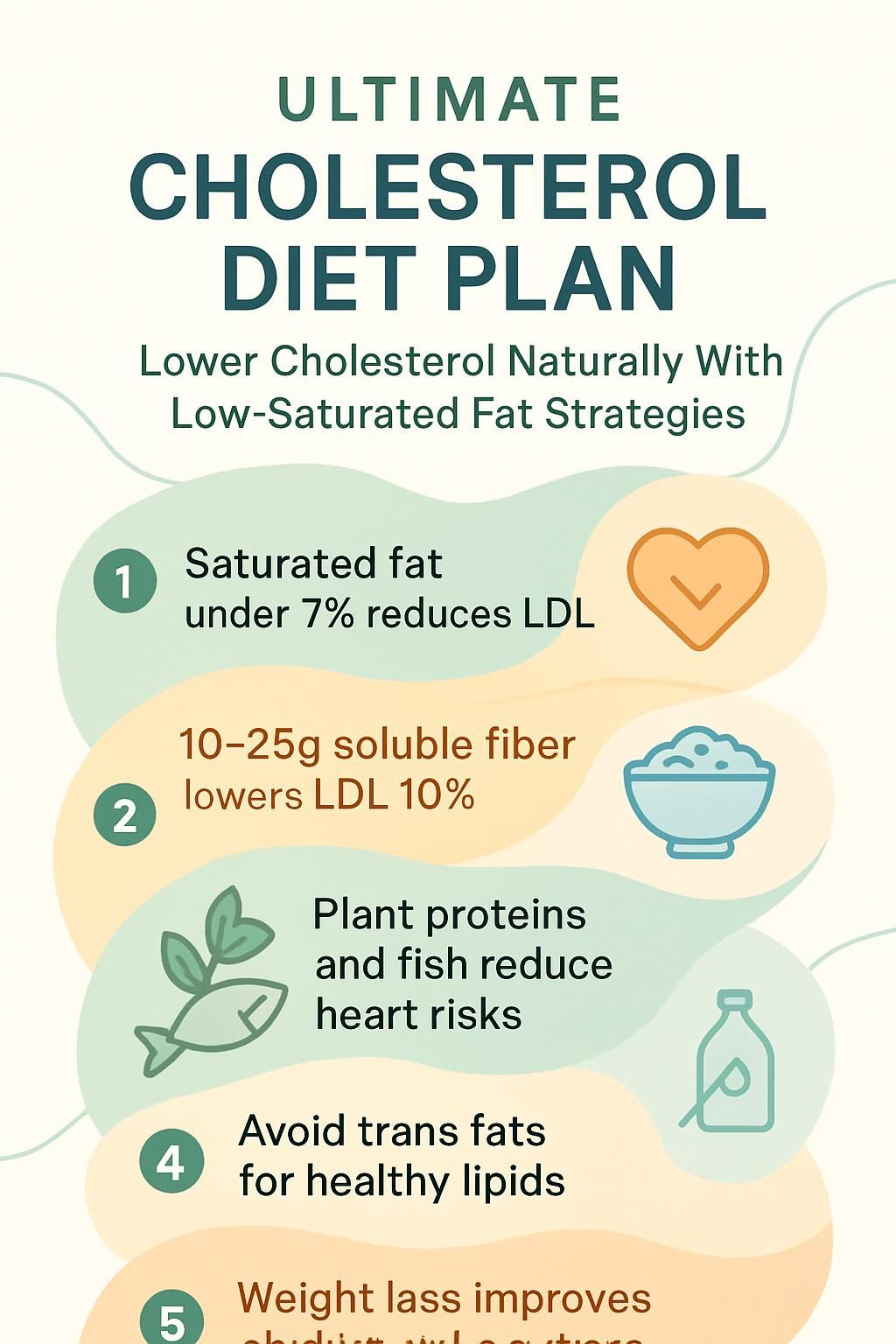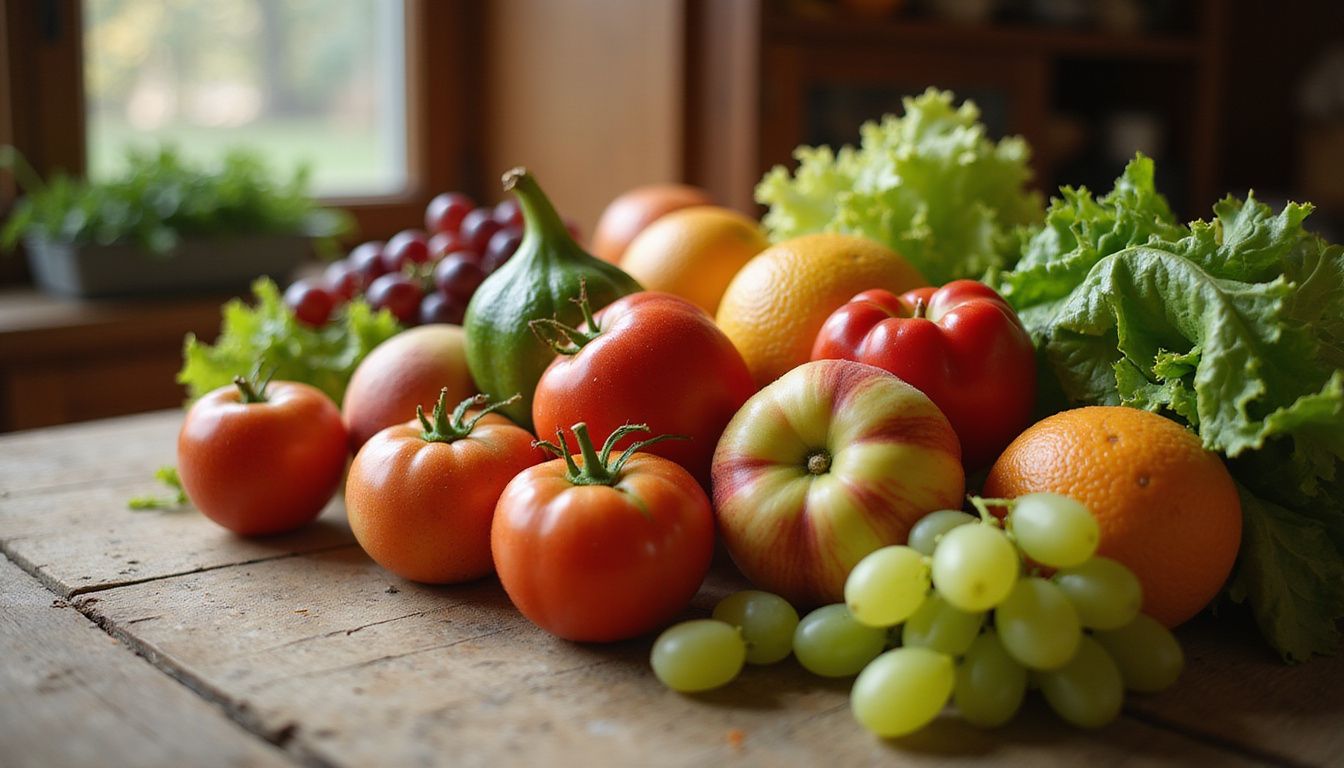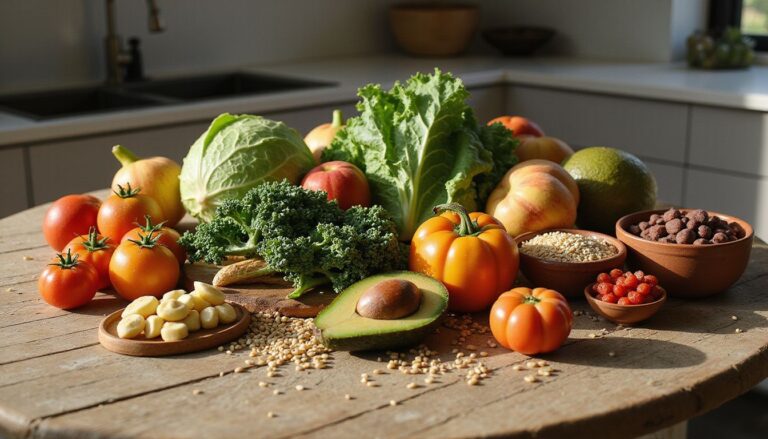Ultimate Cholesterol Diet Plan: Lower Cholesterol Naturally With Low-Saturated Fat Strategies
Our Nutrition Assistant AI Suite will transform your body. You will lose fat, get toned, and build muscle. Gain confidence and optimal health.
Lowering your cholesterol can feel confusing. There is a lot of advice, and many foods to sort through. Cholesterol is a waxy substance your body uses for cell walls and hormones. High levels raise the risk of heart disease and stroke.
This guide shows how a smart cholesterol diet plan can help lower your cholesterol using low saturated fat strategies. You will get simple swaps, meal ideas, and practical steps that fit daily life. Start building habits today that keep your heart strong for years.
Key Takeaways
- Cutting saturated fat to under 7% of daily calories can lower LDL by 8 to 10 percent, based on National Institutes of Health guidance.
- Eating 10 to 25 grams of soluble fiber each day, from oats and beans, can reduce LDL absorption by up to 10 percent in clinical trials.
- Replacing fatty meats and full-fat dairy with plant proteins, nuts, olive oil, and omega-3 fish lowers the risk of cardiovascular disease in American Heart Association guidance.
- Trans fats in partially hydrogenated oils were banned in the United States in 2020. Avoiding any remaining sources still supports healthy blood lipids, per the FDA.
- Portion control and a healthy weight improve cholesterol numbers. Even modest weight loss can help, according to the American Heart Association.

Understanding Cholesterol Basics

Cholesterol has a big job in your body. It supports cell membranes, vitamin D production, and hormones. Learning how cholesterol works helps you choose foods that support a low-cholesterol diet and lower LDL.
What is cholesterol?
Your liver makes most of your cholesterol. Food adds some as well. Cholesterol travels in the blood inside particles called lipoproteins. The two main types are LDL, which is low-density lipoprotein, and HDL, which is high-density lipoprotein.
Too much cholesterol in the blood can stick to artery walls. The buildup forms plaque that narrows arteries and raises the risk of heart disease and stroke. Healthy eating patterns and smart lifestyle choices help lower LDL and support stable blood pressure and triglycerides.
What are the differences between LDL and HDL cholesterol?
Knowing how LDL and HDL differ makes cholesterol management easier. The table shows their roles and goals.
| Type | Full Name | Known As | Main Function | Impact on Health | Ideal Level (mg/dL) | Key Facts |
|---|---|---|---|---|---|---|
| LDL | Low-Density Lipoprotein | “Bad” Cholesterol | Delivers cholesterol to tissues, can deposit on artery walls | High levels raise risk of atherosclerosis and heart disease | Below 100 |
|
| HDL | High-Density Lipoprotein | “Good” Cholesterol | Returns extra cholesterol to the liver for removal | Higher levels protect against heart disease | Above 60 |
|
Once you understand the roles of LDL and HDL, the next step is shaping your diet to improve both.
Why should I manage my cholesterol levels?
Excess cholesterol can build up in your arteries. That raises the risk of coronary artery disease and heart attacks. LDL is often called bad cholesterol because it drives plaque buildup and can reduce blood flow.
Extra body weight also matters. It often raises LDL and lowers HDL, the helpful kind. Millions of Americans face high cholesterol. Choosing foods that lower cholesterol, staying active, and watching portions can prevent future problems.
After shifting to more whole grains, fruits, and vegetables, and cutting back on fatty meats and full-fat dairy, my total cholesterol dropped by 40 points in three months.
Early action, guided by healthy eating and movement, lowers long-term risk. The National Institutes of Health supports these steps with strong evidence.
How Diet Influences Cholesterol
What you eat can change your blood cholesterol. Smart choices support a heart-healthy lifestyle and lower the risk of heart disease.
How does diet affect cholesterol levels?
Meals high in saturated fat, trans fat, or ultra-processed foods raise LDL and increase heart disease risk. The 2020 to 2025 Dietary Guidelines for Americans advise limiting saturated fat to less than 7 percent of daily calories.
Choosing fiber-rich foods, like oats and beans, helps lower LDL. Patterns such as the DASH eating plan and the Therapeutic Lifestyle Changes diet focus on fruits, vegetables, whole grains, and lean proteins. Swapping butter for olive oil or avocado reduces unhealthy fats.
Clinical trials show that adding 5 to 10 grams of soluble fiber per day can drop LDL by up to 5 percent. Reading Nutrition Facts labels keeps you aware of hidden fats and added sugars that affect blood lipids.
What are the benefits of a low-saturated fat diet?
Limiting saturated fat helps reduce LDL, the main driver of plaque. The TLC diet from the National Institutes of Health suggests keeping total fat at 25 to 35 percent of calories, with saturated fat under 7 percent. On a 2,000-calorie diet, that is about 13 grams of saturated fat per day.
Replacing fatty meats, full-fat dairy, butter-based baked goods, and fried snacks with foods rich in unsaturated fats improves blood lipids. Good options include walnuts, olive oil, salmon, avocado, and flaxseed.
Many studies show these changes help lower the risk of heart attack and stroke in places with high rates of high cholesterol. The next section covers high-fiber foods that make a clear difference.
Best Foods to Eat for Lowering Cholesterol
Picking the right foods can lower your cholesterol naturally. Use this section to match meal choices with a heart-healthy diet.
Which high-fiber foods help reduce cholesterol?
High-fiber foods, especially soluble fiber, reduce cholesterol absorption. Add these options to your daily meal plan.
- Oatmeal and oat bran provide 3 to 4 grams of soluble fiber per serving. This helps lower LDL.
- Fruits such as apples, bananas, oranges, pears, and prunes add fiber and support healthy cholesterol.
- Legumes like kidney beans, lentils, chickpeas, and black-eyed peas offer soluble fiber and plant protein.
- Whole-grain cereals supply complex carbs and fiber. Oatmeal makes a strong breakfast choice.
- Vegetables including carrots, broccoli, Brussels sprouts, and sweet potatoes deliver helpful fiber types.
- Chia seeds and almonds lift fiber intake and add healthy fats.
- A daily goal of 10 to 25 grams of soluble fiber can cut the amount of cholesterol your body absorbs.
My dietitian suggested oatmeal with a banana each morning. Three months later, my LDL improved without any medication changes.
Why include fatty fish rich in omega-3s?
Fatty fish, such as salmon, sardines, and mackerel, are rich in omega-3 fatty acids. Omega-3s help lower triglycerides and support heart rhythm. Two fish servings per week can improve heart health, according to the American Heart Association.
Plant sources include walnuts, flaxseeds, chia seeds, and canola oil, though they provide different forms of omega-3. Try grilled salmon on a salad or canned tuna on whole-grain bread. Choosing fish instead of meats high in saturated fat supports better cholesterol control.
How do nuts and seeds support cholesterol control?
Almonds, walnuts, and other nuts help lower LDL while supporting HDL. A daily 1.5-ounce portion of unsalted nuts can reduce total and LDL cholesterol. Walnuts support heart health, and regular intake links with fewer cardiac events.
Seeds, such as chia and flax, supply fiber and plant sterols that reduce cholesterol absorption. These foods replace saturated and trans fats found in fatty meats and many snack foods. Keep portions modest since nuts are calorie dense. Add chopped almonds to oatmeal or toss sunflower seeds into salads for crunch without extra sodium.
What role do avocados and olive oil play?
Avocados provide monounsaturated fat and fiber. Both improve cholesterol numbers. A couple of servings per week can lift HDL and lower LDL. Use avocado in salads, guacamole, or on whole-grain toast.
Olive oil is a simple swap for butter in cooking. Use it to sauté vegetables, mix dressings, or bake. Studies link regular olive oil use with a lower risk of heart attack through better cholesterol balance.
Are foods fortified with plant sterols or stanols effective?
Foods fortified with plant sterols or stanols can help block cholesterol absorption in the gut. Eating about 2 grams per day may reduce LDL by 5 to 15 percent. Fortified spreads and certain juices are common sources.
Many healthcare providers suggest these products as part of diet changes to lower cholesterol. Check the Nutrition Facts label to confirm the amount per serving. Research shows steadier LDL reductions with regular use and few side effects.
How do legumes like beans and lentils help?
Legumes, including beans, lentils, chickpeas, and peas, are rich in soluble fiber. This fiber binds cholesterol in the gut so your body can remove it. One cup of cooked beans or lentils provides about 6 to 8 grams of fiber.
Studies show that 5 to 10 grams of soluble fiber per day can reduce LDL by up to 10 percent. Swapping white rice for lentil soup twice a week can improve fullness and digestion. Legumes contain almost no saturated fat, which makes them a smart alternative to fatty meats and full-fat dairy products.
For steady progress, aim for three or more servings per week. Use simple spices and herbs instead of heavy sauces that add sugar or unhealthy fats from hydrogenated oils.
Which vegetables and fruits lower cholesterol?
Vegetables and fruits supply fiber and antioxidants that support cholesterol control. Focus on soluble fiber and colorful produce.
- Oats, apples, pears, and citrus fruits provide soluble fiber that traps cholesterol for removal.
- Berries, such as blueberries and strawberries, offer antioxidants that help lower LDL.
- Leafy greens like spinach and kale add vitamins A and C and helpful plant compounds.
- Carrots contain pectin, a soluble fiber that can reduce total cholesterol.
- Brussels sprouts and broccoli give fiber and plant protein while keeping saturated fat low.
- Avocados supply healthy fats that can replace saturated fat and support LDL reduction.
- Beans and lentils deliver fiber and protein, as noted by the Department of Health and Human Services.
- Tomatoes add vitamin C and lycopene. Regular intake of lycopene has been linked with lower LDL.
- Frozen or canned vegetables still count. Extra servings improve diet quality with little effort.
Learning how these foods fit your day helps you limit foods high in saturated fat next.
Foods to Limit or Avoid for Cholesterol Control
Your food choices affect cholesterol levels. Some items raise risk and are best limited to protect heart health.
Why avoid saturated fats from fatty meats and full-fat dairy?
Eating a lot of saturated fat from fatty meats and full-fat dairy raises LDL. Experts suggest keeping saturated fat below 7 percent of daily calories to reduce risk. Cutting these fats can lower LDL by 8 to 10 percent.
Major sources include red meat, butter, cheese, and whole milk. Swap these items for plant-based proteins or healthy fats like olive oil. Many people see better cholesterol numbers when they limit processed meats and full-fat dairy and add more vegetables, legumes, nuts, seeds, and healthy oils.
What are trans fats and which foods contain them?
Trans fats raise LDL and lower HDL, increasing heart disease risk. On labels, trans fats often appear as partially hydrogenated oil. Food makers once used them in packaged snacks and some margarines to extend shelf life.
The FDA banned partially hydrogenated oils in processed foods starting January 1, 2020. You may still see trace amounts in some imported or older products. Check for the phrase partially hydrogenated on ingredient lists to avoid hidden trans fats.
Reading labels at the grocery store helped me find sources I would have missed. Limiting these foods supports a healthy cholesterol diet plan.
How do refined carbs and sugars affect cholesterol?
Refined carbs and sugars can raise LDL and triglycerides. Foods like white bread, pastries, sugary cereals, and soda add calories but not fiber. Your body breaks them down fast, causing blood sugar spikes. Over time, the liver makes more triglycerides and LDL.
These foods do not raise HDL. In fact, they can lower it. People who eat many added sugars tend to have worse cholesterol profiles. Choose whole grains instead of refined ones to support heart health.
Next, see why limiting high-fat and processed meats also matters.
Why limit high-fat and processed meats?
Bacon, sausage, hot dogs, and some deli meats contain a lot of saturated fat and dietary cholesterol. Eating them can raise LDL. Research from the American Heart Association links even two servings per week with higher heart disease risk.
One slice of cooked bacon has about 1 gram of saturated fat. Several slices add up quickly. Studies in journals such as Circulation connect processed meat intake with more heart attacks and strokes. Swap high-fat meats for plant proteins or omega-3 fish to support better numbers. Regular exercise works with diet changes for stronger results.
Dietary Strategies to Lower Cholesterol
Use these strategies to lower cholesterol with your fork. Small, steady changes can pay off.
How can increasing soluble fiber help?
Soluble fiber acts like a sponge. It traps cholesterol in your gut so less enters your blood. Oats, beans, apples, lentils, barley, and many vegetables contain this fiber.
Experts recommend 10 to 25 grams of soluble fiber daily. A bowl of oat bran at breakfast and beans or lentils at lunch can help you reach that range. I switched from white bread to whole grain bread rich in soluble fiber. Three months later, my cholesterol check showed better LDL.
Use vinaigrette on salads loaded with chickpeas and greens for a simple boost.
What healthy fats can replace saturated and trans fats?
Choose unsaturated fats instead of saturated and trans fats. Cook with olive, canola, or safflower oil. These oils contain monounsaturated and polyunsaturated fats that support heart health.
Lean meats offer protein with less saturated fat than fatty cuts. Add nuts like almonds or walnuts to snacks or oatmeal. A small handful daily may reduce LDL by up to 5 percent. Avocados provide healthy fat plus fiber.
Swap butter for olive oil in sautéing or sauces. Replace processed foods that use hydrogenated oils with home-cooked meals using nuts, seeds, and plant-based spreads. The American Heart Association suggests keeping saturated fat under 6 percent of your calories.
Why incorporate plant-based protein sources?
Plant proteins such as lentils, chickpeas, beans, and nuts are low in saturated fat. Diets lower in saturated fat reduce LDL and support heart health. The American Heart Association notes that a half cup of cooked beans per day can reduce total cholesterol by up to 8 percent.
These foods also add fiber, which slows cholesterol absorption. I replaced ground beef with black bean tacos and felt lighter after meals. Try walnuts on oatmeal or hummus on sandwiches instead of deli meats.
- “Dietary Pulses Reduce LDL Cholesterol: A Systematic Review,” Canadian Medical Association Journal, 2014
- American Heart Association recommendations on protein choices
What are healthy cooking methods for lowering cholesterol?
Bake, broil, poach, or roast to avoid extra fat from frying. Roast vegetables with a light drizzle of olive oil instead of deep frying in butter. Use canola or sunflower oil to replace saturated fats from butter and full-fat dairy.
Poach fish with water, lemon, and herbs for flavor without added fat. Broil chicken on a rack so fat drips away. These methods lower unhealthy fat intake and support cholesterol management, as supported by American Heart Association research.
How does controlling portion sizes aid cholesterol management?
Portion control helps prevent weight gain. Extra weight can raise LDL and lower HDL. Smaller portions keep calories in check and support a healthy weight.
Use a smaller plate or measure servings of rice and pasta to avoid overeating. Even moderate weight loss improves cholesterol numbers. Switching to single-serving snacks, like a small pack of nuts, made it easier for me to stay on track.
Next, put these strategies together in a simple 7-day plan.
Sample 7-Day Cholesterol-Lowering Meal Plan
Use this 7-day plan for structure. Mix and match ideas to fit your routine.
Day 1: Breakfast, lunch, dinner, and snacks
Breakfast: chia and oat pudding for soluble fiber and omega-3s. Lunch: tuna pasta salad made with whole-grain pasta for extra fiber and lean protein. Dinner: chicken and broccoli stir-fry cooked in olive oil to keep saturated fat low.
Snacks: apple slices or berries, plain yogurt, veggie sticks with hummus, and a small handful of unsalted nuts or seeds. These choices support healthy cholesterol without trans fat or excess sugar.
Day 2: Breakfast, lunch, dinner, and snacks
Breakfast: Bircher muesli topped with plain nuts and seeds. Lunch: whole-wheat pita with greens, hummus, and either beans or lean meat. Dinner: falafel tray bake with chickpeas and roasted vegetables.
Snacks: fresh fruit, plain yogurt with no added sugar, veggie sticks with hummus, or a small portion of unsalted nuts or seeds. This plan kept meals interesting and helped me control my cholesterol using low saturated fat swaps.
Day 3: Breakfast, lunch, dinner, and snacks
Breakfast: warm porridge with plain yogurt, sliced fruit, and a sprinkle of nuts and seeds. Lunch: salad with spiced pumpkin, lentils, and tofu cubes on leafy greens. Dinner: blackened fish tacos on whole-grain tortillas with cabbage, salsa, and avocado.
Snacks: fruit pieces, plain yogurt, veggie sticks with hummus, and a small handful of nuts or sunflower seeds. These choices deliver nutrients without extra saturated fat or sugar. Preparing similar meals weekly has helped my family stick to a cholesterol-friendly plan.
Day 4: Breakfast, lunch, dinner, and snacks
Start with whole-grain toast topped with avocado, tomato, and sesame seeds. Lunch: chickpea fattoush with cucumbers, tomatoes, radishes, greens, and baked pita chips. Dinner: a poke bowl with brown rice or quinoa, salmon or tofu, edamame, seaweed salad, carrots, cucumbers, and mango. Add a light drizzle of soy sauce or sesame oil.
Snacks: fresh fruit, nonfat plain yogurt, veggie sticks with hummus, and a small portion of nuts or seeds. Eating about 1 ounce of nuts daily may lower LDL by around 5 percent within weeks^1^.
Following this approach helped me keep my cholesterol in check after my doctor’s advice last spring.
Low saturated fat meals built around these choices can support healthier cholesterol levels over time.
…
[1] Jenkins DJA et al., “Nuts as a Replacement for Carbohydrates in the Diabetic Diet,” Diabetes Care, 2011.
Day 5: Breakfast, lunch, dinner, and snacks
Breakfast: natural muesli with plain yogurt, fresh fruit, and sunflower seeds. Lunch: sardines and spinach on whole-grain toast for omega-3s and plant sterols. Dinner: winter vegetable and barley soup, a rich source of soluble fiber.
Snacks: whole fruits, plain yogurt, veggie sticks with hummus, or a handful of unsalted nuts and seeds. These options kept me full during busy days and matched my lab results from last year.
Experts recommend limiting saturated fats. Diets lower in saturated fat can decrease LDL by up to 10 percent, according to the American Heart Association, July 2022.* Choosing these evidence-based foods supports your cholesterol diet plan.
…
*Source: American Heart Association, July 2022.
Day 6: Breakfast, lunch, dinner, and snacks
Breakfast: homemade baked beans for plant protein and fiber. A study in the Journal of Nutrition found that eating legumes four times a week may cut heart disease risk by up to 22 percent.
Lunch: tofu salad with miso dressing for soy protein and probiotics. Dinner: chili mince and beans in lettuce cups or soft wraps to add soluble fiber with lean protein.
Snacks: fresh fruit, plain yogurt, veggie sticks with hummus, or plain nuts and seeds. I made similar swaps at home, and my cholesterol numbers dropped after three months.
Day 7: Breakfast, lunch, dinner, and snacks
Breakfast: cooked mushrooms, spinach, and tomatoes on whole-grain toast. Lunch: quesadillas with fresh avocado salsa for monounsaturated fat. Dinner: chicken and chickpea curry for lean protein and soluble fiber.
Snacks: fruit, plain yogurt, veggie sticks with hummus, and a handful of unsalted nuts or seeds. Plant sterols in nuts help lower blood cholesterol naturally.
Additional Tips for Success
Small changes add up. Use these tips to fine-tune your plan and stay consistent.
How to read food labels for hidden fats and sugars?
Check total fat, saturated fat, trans fat, cholesterol, fiber, sodium, and added sugars on the Nutrition Facts panel. Focus on saturated and trans fats since they raise LDL. The American Heart Association suggests less than 6 percent of calories from saturated fat, which is about 13 grams on a 2,000-calorie diet. Keep trans fats at zero.
Look for added sugars, such as sucrose and high-fructose corn syrup. Some products hide several forms in one item. One granola bar I checked listed four different added sugars. Compare brands. Some yogurts have up to 15 grams of added sugar per serving, while others have far less.
Portion sizes on the label matter. If you eat more than one serving, you also eat more fat and sugar. Drinking enough water and limiting alcohol can support your goals.
Why stay hydrated and limit alcohol intake?
Water supports digestion and helps your body remove waste. Dehydration can thicken blood and strain your heart. Hydration also helps you feel more alert and improves workout performance.
Too much alcohol raises blood pressure and triglycerides. For heart health, men should have no more than two drinks per day. Women should have one or less per day. I noticed better energy when I swapped extra drinks for water with lemon at social events.
Drinking water and keeping alcohol low makes cholesterol management easier and safer.
How does regular physical activity help cholesterol?
Regular activity can raise HDL and lower LDL. Aim for at least 150 minutes of moderate exercise each week. Brisk walking, cycling, or swimming for 30 minutes most days works well.
The American Heart Association notes that active adults can increase HDL by 5 to 10 percent. Exercise also supports a healthy weight. Adding daily walks helped me lower total cholesterol within six months.
How to monitor progress and adjust your diet?
Schedule follow-up blood tests as your healthcare provider suggests. Many experts advise retesting three months after diet changes, then every 6 to 12 months once stable. Track LDL, HDL, total cholesterol, and triglycerides. High-risk adults often aim for LDL under 100 mg/dL.
Use a food diary or an app to spot patterns. If levels do not improve, replace remaining saturated fat sources like butter and processed meats with olive oil, avocado, and nuts. Increase high-fiber foods such as beans and oats. Each extra 5 grams of soluble fiber per day may reduce LDL by up to 5 percent.
Make one change at a time. Small steps are easier to keep. Talk with your healthcare provider if you take cholesterol medicines or have other conditions.
*Sources:
[1] American Heart Association Cholesterol Guidelines, July 2019.
[2] Jenkins DJA et al., “Diet Portfolio Study,” JAMA, 2003.
Health Benefits of Lowering Cholesterol
Lower cholesterol supports heart health and steady energy. Many people feel better as they follow a low saturated fat plan.
How does lowering cholesterol improve heart health?
Reducing LDL helps keep arteries open and flexible. High LDL leads to plaque buildup that narrows arteries. Narrow arteries force the heart to work harder and raise the risk of chest pain, heart attack, or blocked vessels.
Doctors emphasize LDL control because research links lower levels with fewer heart problems. People who move to a diet rich in fruits, vegetables, and whole grains see gains over time. I noticed better cholesterol numbers and more energy after replacing processed snacks with high-fiber foods.
How does it reduce cardiovascular disease risk?
Lower LDL means less fatty buildup in arteries. This reduces blockages that can trigger heart attacks or strokes. Data suggests each 1 percent drop in LDL cuts heart disease risk by about 2 percent. A 30 percent drop in LDL could reduce major cardiac events by up to 60 percent.
Limiting saturated and trans fats protects blood vessels. Avoiding fatty meats, full-fat dairy, and many processed foods lowers inflammation and improves cholesterol levels. Managing sodium and alcohol also helps maintain healthy blood pressure, which adds protection.
What overall well-being benefits can I expect?
Many people report higher energy, better digestion, and easier weight control. Balanced meals with fiber support steady blood sugar, which can lead to a more stable mood.
A fiber-rich diet has been linked with lower inflammation and a healthier gut. I felt fewer afternoon slumps and slept better after swapping heavy meats for bean-based lunches two days a week.
In short, expect better daily energy, more digestive comfort, steadier mood, and improved weight management from a cholesterol-lowering diet built on whole grains, vegetables, legumes, nuts, seeds, avocados, and olive oil, with fewer processed foods and saturated fats.
Conclusion
Choosing a cholesterol diet plan centered on low saturated fat helps you take control of heart health. Small daily steps, like eating high-fiber foods, cooking with olive oil, and picking lean or plant proteins, add up.
Filling your plate with fruits and vegetables, whole grains, and omega-3 fish can lower LDL cholesterol. Limiting full-fat dairy, processed meats, refined sugars, and trans fats supports your progress. Staying hydrated and active strengthens the effect.
Consistency is the secret. With steady effort, you can lower your cholesterol naturally and enjoy a balanced eating plan that fits your life. This information is educational and does not replace medical advice. Work with your healthcare provider for a plan that matches your needs.
FAQs
1. What foods should I eat on a cholesterol diet plan focused on low-saturated fat strategies?
Choose whole grains, beans, lentils, fruits like apples and berries, vegetables such as broccoli and spinach, nuts in small amounts, and fish rich in omega-3 fatty acids. These foods contain fiber or healthy fats that help lower LDL cholesterol.
2. How effective is reducing saturated fat for lowering cholesterol naturally?
Clinical studies show that cutting back on saturated fat can reduce LDL (bad) cholesterol by up to 10 percent within weeks. Replacing butter or fatty meats with olive oil or lean poultry supports heart health according to the American Heart Association.
3. Can you provide data comparing common food choices for a low-cholesterol diet?
Yes; see the table below:
Food Item | Saturated Fat (g per serving) | Cholesterol (mg per serving)
Skinless chicken breast | 0.9 | 73
Salmon fillet | 1 | 60
Oatmeal | 0 | 0
Butter| 7 | 31
Cheddar cheese| 6 | 30
These numbers highlight how plant-based options and lean proteins are better choices than high-fat dairy products.
4. Is it possible to follow this diet plan long-term based on personal experience?
After switching from processed snacks to oatmeal breakfasts and grilled fish dinners over six months, my total cholesterol dropped by twenty points without medication support. This approach offers sustainable results when paired with regular exercise.
Summary: A well-planned diet using low-saturated fat strategies helps lower bad cholesterol levels naturally while supporting overall cardiovascular wellness through evidence-based food choices and lifestyle changes.







